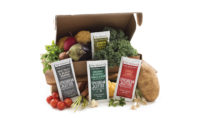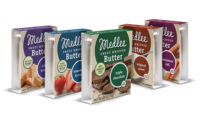Retail sales of branded butter showed gains on private label butter in the last year. Though dollar sales of private label butter increased 3.4%, unit sales decreased 1.3%, suggesting that retailers raised prices. The leading brands, Land O Lakes and Challenge, showed unit sales increases of 5.3% and 6.7%, respectively (see table). Information Resources Inc., Chicago, reported the data for the 52 weeks ended Sept. 4, 2016.
Milk | Cheese | Cultured | Ice Cream | Butter | Non-dairy Beverages | Ingredients | Exports
Overall, the butter products measured by IRI increased dollar sales by 5.8% on unit sale increases of 1.7%. The story is different for margarines and butter blends. Dollar sales of margarine dropped 2% and unit sales dropped 3.4%. The picture is worse for the much-smaller butter blends segment. Unit sales plunged 34.8%, causing dollar sales to plummet 25.1%.
A growing appetite
Annual per capita butter consumption has increased almost one pound in the last 10 years. In 2015, Americans ate 5.6 pounds of butter, compared to 4.7 pounds in 2006, according to the U.S. Department of Agriculture.
After rising for six consecutive months at the end of 2015, butter prices dropped in January of this year. They rebounded for three months and declined again from May through July. In August, the Consumer Price Index for butter rose 1.5%. On the supply side, monthly U.S. butter production peaked in March of this year and has declined every month since then.
Inventive new products
Dairy processors continued to develop new products. Arden Hills, Minn.-based Land O’Lakes developed a pumpkin pie spice flavor for sales during the holiday baking season. This limited-time offer follows the lead of ice cream makers and fluid milk processors, who regularly release new flavors based on seasons or events.
In the October Dairy Foods, Land O’Lakes COO Beth Ford said the dairy cooperative’s research and development team is working on butters with added health benefits, such as Omega-3. Consumers seek foods with added healthy ingredients rather than those making “less than” claims.
“We’re looking at that from a health platform perspective. We also look at convenience. We’re looking at packaging types. There are a number of items that we’re looking at in our innovation portfolio that will allow us to continue to grow. But as I say, we still are growing in that butter category and are growing above the category level at a healthy rate.”
Grassland Dairy Products, Greenwood, Wis., is relaunching its flagship retail brand called Grassland.
“The retail line will feature a fresh take on our classic packaging design. We have also monitored consumer demands and trends, and our brand will be rBST-free,” said Grassland President Trevor Wuethrich.
New products from the Wisconsin creamery include a clarified butter packaged for retail consumers in 8-ounce cups. It is also packaging its premium foodservice butter for the retail market. Called Wüthrich, the 83% fat European-style butter is sold as one-half pound consisting of two quarter-pound sticks. It will also offer an imported, grass-fed butter from New Zealand called Mountain View as two quarter-pound sticks.
Butter abroad
In a semi-annual report published in May, the Global Agricultural Information Network of the USDA Foreign Agricultural Service wrote, the “exports are expected to grow because of continuing demand for butter from the U.S. and Saudi Arabia and for butter oil from China.”
By late this summer, the picture had changed. The U.S. Dairy Export Council reported that year-to-date (through August) butterfat exports were down 12% from the same period in 2015. “U.S. butterfat remained priced out of the world market in August,” USDEC wrote in its Global Dairy Market Outlook.
Butter makers could find export opportunities. In September the Japanese government said it will import another 4,000 metric tons of butter, bringing the country’s butter imports to a record high of 17,000 metric tons. That was perhaps the only bright spot.
Back in the United States, butter makers are promoting their products’ clean label, just like processors of other dairy products do. The butter industry also is touting research that has disproved butter’s reputation as a “bad” fat.
“Recent studies showing the benefits of full-fat dairy will be a tremendous boost for dairy product sales,” said Maureen Lee, Grassland’s director of marketing and communications. “Millennials and the aging demographic are the largest population groups. Millennials and older adults are looking for simple, clean products with no additives, natural and shows a story behind the food. Dairy really exceeds that profile as a simple food that begins on a farm,” she said.
What’s the industry talking about?
- Growth in branded butters
- Flavored butter
- Adding health benefits (Omega-3s, for example)
- Domestic demand
- Dearth of exports
- ‘Fat’ is not a bad word
- rBst-free and grass-fed
- Lower retail prices
Milk | Cheese | Cultured | Ice Cream | Butter | Non-dairy Beverages | Ingredients | Exports













